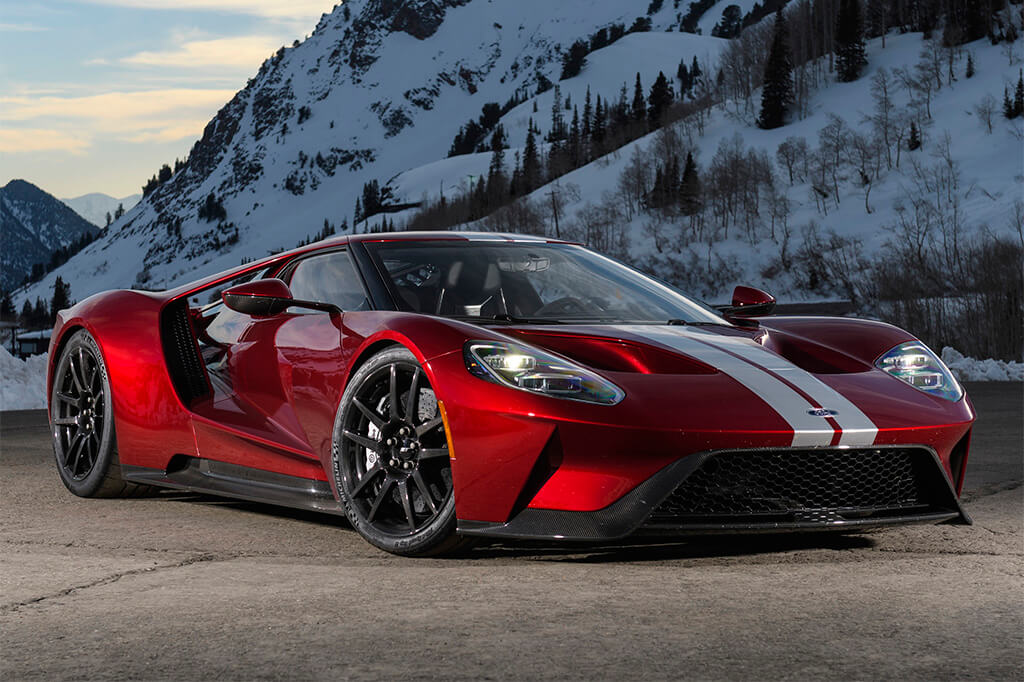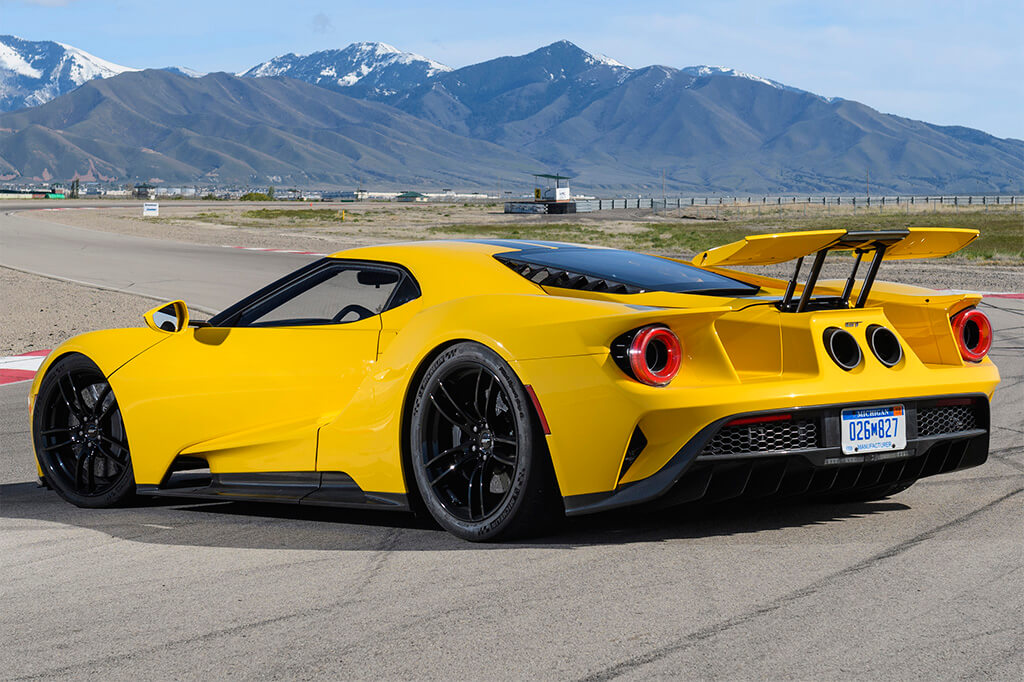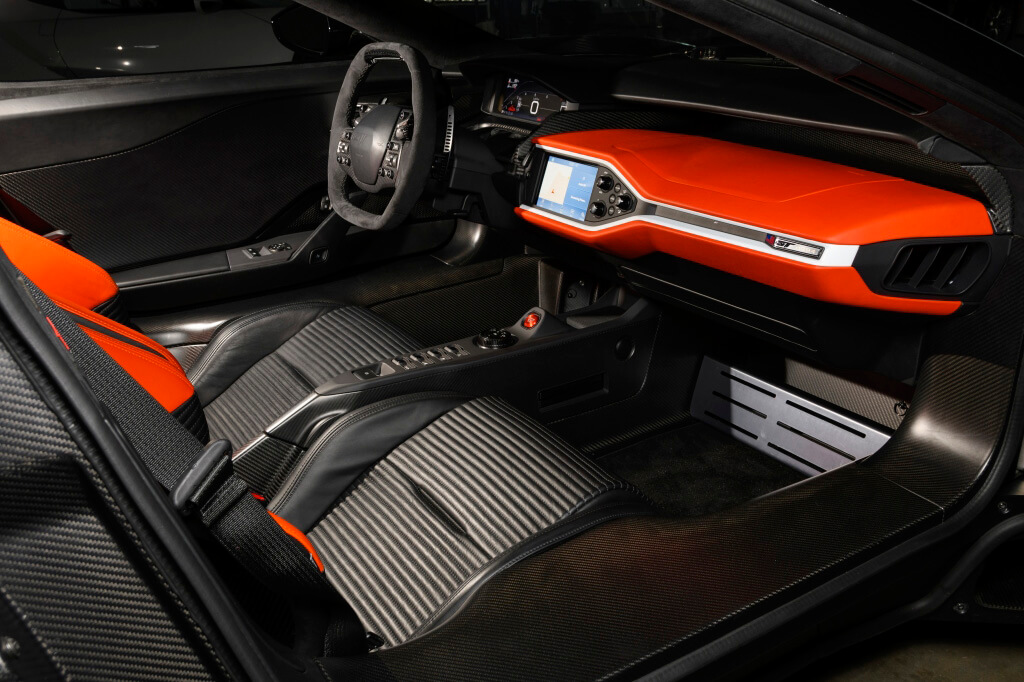Ford GT (Mk2)
| Basic model: |
|---|
Description
The Ford GT is a two-seater sports coupe that is the second generation of the current successor to the GT40.
Story
Introduced at the 2015 North American International Auto Show in Detroit, series production of the second-generation Ford GT began in December 2016 with a planned production rate of one car per day at Ford Multimatic's all-new, low-volume assembly plant in Markham, Ontario, Canada, with an estimated release date until 2020. In total, 1350 copies of all versions were planned for release.
2017 and 2018 vehicles were reserved for select buyers, 2019 vehicles were reserved for pre-qualified buyers, and 2020 vehicles were available to anyone.
Approximately two hundred 2017 and 2018 vehicles were recalled to address a potential hydraulic system leak and fire risk.
The second-generation Ford GT was one of more than 12 new Ford Performance vehicles scheduled to launch before 2020. It was to join the Focus RS, F-150 Raptor, Shelby GT350 and Shelby GT350R in Ford's growing Performance lineup.
The cost of the second generation Ford GT supercar was 400-500 thousand US dollars.
Engine
The car was equipped with a 3.5-liter Ford EcoBoost V6 twin-turbo engine developing 647 hp. (482 kW) and 746 Nm of torque. The all-aluminum engine with a 60-degree camber angle was 60% unified with the Ford Raptor pickup engine. They shared a common cylinder block, cylinder heads, valve covers, ignition and power systems with combined injection. Everything else was original. First of all, it is a dry sump lubrication system with a four-section pump. Moreover, the base of the 14.5-liter oil tank was a supporting structure for attaching attachments transferred to the rear of the engine. This arrangement made it possible to move the entire power unit deeper into the base, improving weight distribution and minimizing the moment of inertia of rotation around the vertical axis. The list of unique components continued with forged crankshaft and connecting rods supplied by Roush, Honeywell turbochargers (1.8 bar peak), head gaskets, water pump and gas distribution mechanism with variable valve lift. The engine was not built by Multimatic, but by an unnamed contractor owned by Ford.
One of the main features of this engine was a fancy intake system. Intermediate charge air coolers were spaced apart on the side pontoons for the sake of aerodynamics. The air ducts from the intercoolers to the throttle were laid inside the body pylons, which are also an element of the plumage. The air intake was carried out in the region of the rear wheel arches.
Transmission
The gearbox was a Getrag 7DCL750. Which was a 7-speed robotic gearbox with two clutches, combined in one housing with the main pair: such units were installed either on mid-engine cars with a longitudinal engine, or front-engine ones, in which the box was moved back. The box was designed to work with "revving" sports engines (up to 9500 rpm), the maximum input torque is up to 750 N∙m.
In various versions, this gearbox was installed on the mid-engined Ford GT, Ferrari 458 and 488, as well as the front-engined Ferrari California and Ferrari F12, Mercedes-Benz SLS and Mercedes-AMG GT. Between themselves, they differ in gear ratios and clutch housings.
But the cost of the box itself differed significantly depending on the brand under which it was installed. As American journalists found out, the box for Ford (part number HG7Z-7000-A) is the most expensive: it cost the buyer $27,624. Moreover, this is subject to an exchange for an old box: otherwise, another five thousand US dollars would have to be paid. This is significantly more expensive than even a Ferrari: the box from the 458 supercar, number 263938, cost “only” $22,186. The AMG GT transmission, numbered A1902600500, cost $14,940. In addition, the customer had the opportunity to save money by purchasing a factory refurbished box, which cost $11,715.
Chassis
According to Ford, "The GT has one of the best weight-to-power ratios in a road car" thanks to its lightweight carbon fiber construction. The structure of the GT consisted of a carbon fiber monocoque coupled to aluminum subframes front and rear, over which carbon fiber body panels were mounted. The roof was reinforced with a tubular structure closely replicating the outer canvas of an FIA racing carcass with the same section. In both cases, the 15CDV6 chromium-molybdenum alloy was used. The carbon fiber monocoque consisted of 45 injection molded parts. This technology made it possible to simplify both production and repair.
The architecture of the double-wishbone suspension with shock absorbers placed on the body resembled the scheme used on sports prototypes. One of their oldest developers, Lola, was a division of Multimatic, one of the developers. As elastic elements, not only torsion bars were used, like in a racing GT, but also traditional twisted springs. Everything was assembled on hinges. The spring was combined with a hydraulic actuator, which acted through the torsion bar on the rocker, connected by a link to the lower arm. Turning off the spring, the lock turned the rocker, and thus the ground clearance changed within 70-120 mm. The reverse stroke of the actuator gave a special elegance to the solution, thanks to which the rocker turned in the other direction, and the front of the car was raised by 50 mm.
The car was fitted with 20-inch forged aluminum wheels with Michelin Pilot Sport Cup 2 tires measuring 245/35 at the front and 325/30 at the rear. For an additional fee, it was possible to install Shelby Mustang GT350R carbon fiber wheels, which, in addition to increased strength, were almost one kilogram lighter than standard ones.
Brake system
The braking system was Brembo ventilated carbon-ceramic discs with six-piston calipers at the front and four-piston calipers at the rear.
Exterior
An important difference between a road car and a racing car is active aerodynamics. The body was originally designed with an emphasis on downforce, and for the civilian version, top speed was also important. In addition, it was necessary to maintain an aerodynamic balance depending on the position of the wing. So, motorized dampers appeared under the front bumper, redirecting the flow depending on the selected mode. When the channel was closed, the pressure was higher due to the acceleration of the flow under the bottom. When open, part of the air passed over the splitter, reducing resistance. The wing changed its height, angle of attack (including airbrake mode) and geometry, thanks to a movable rear with an integrated drive. At maximum speed, the rear axle was loaded with a force equivalent to the pressure of a mass of 204 kg.
The car was very low and wide; his cabin was shaped like a drop and tapered back, while the muscular rear wings were connected to it by bridges - “flying buttresses”. At the front, a resemblance to the previous Ford GT was given by plastic headlights with rectangular LEDs and recessed "nostrils" of the air ducts. At the rear, the LED ringlights paired well with the twin tailpipes vented down the center. Dihedral doors opened up and to the side ("butterfly" type), instead of swing doors, traditional for Ford GT, opening with part of the roof.
Worthy of special mention is the windshield, which is made from Corning's Gorilla Glass material (a material widely used in the manufacture of smartphones) to reduce weight through thinness without sacrificing strength.
The body had an 11.3 liter luggage compartment at the rear in a thermally loaded area above the gearbox.
Interior
Interior trim was made of carbon fiber and Alcantara. The seats were built into the monocoque and were not adjustable. For ease of landing, the steering column and pedal assembly were adjusted. All the main buttons were centered on a square Formula One-style steering wheel, behind which was a digital instrument cluster. To the right of it was the display of the information system, and below it, on a narrow console, was the engine start button and the rotating gear selector.
Sources
Specification
| Bodywork | |
|---|---|
| Years of production |
2017-2020
|
| Produced (pcs.) |
1350
|
| Body type |
купе
|
| Number of doors |
2
|
| Number of places |
2
|
| Engine | |
|---|---|
| Engine model |
Ford TwinTurbo EcoBoost 3.5 V6
|
| Cylinders |
V6
|
| V-angle |
60°
|
| Capacity (cc) |
3496
|
| Power output (hp / kW /) |
656 /
482 /
|
| at rpm |
6250
|
| Torque (N·m) |
746
|
| at rpm |
5900
|
| Redline (rpm) |
9500
|
| Bore (mm) |
92,5
|
| Stroke (mm) |
86,7
|
| Compression |
9,1
|
| Number of valves |
4/24
|
| Valvetrain |
DOHC
|
| Block material |
алюминиевый сплав
|
| Dry sump |
да
|
| Oil sump capacity (l) |
14,5
|
| Fuel system |
впрыск
|
| Fuel system model |
Bosch
|
| Turbocharger |
2
|
| Compressor model |
Borg Warner K03
|
| Turbo pressure (bar) |
1,8
|
| Specific | |
|---|---|
| Specific output (hp/litre) |
187,64
|
| Specific output (hp/tonne) |
455,56
|
| Specific output (kg/hp) |
2,20
|
| Specific torque (N·m/litre) |
213,39
|
| Specific torque (N·m/tonne) |
518,06
|
| Transmission | |
|---|---|
| Driven wheels |
задний
|
| Clutch |
двухдисковое
|
| Gearbox model |
Magna (Getrag) 7DCL750
|
| Gearbox |
роботизированная
|
| Number of speeds |
7
|
| Final drive ratio |
3,667
|
| First gear ratio |
3,397
|
| Second gear ratio |
2,186
|
| Third gear ratio |
1,626
|
| Fourth gear ratio |
1,285
|
| Fifth gear ratio |
1,029
|
| Sixth gear ratio |
0,839
|
| Seventh gear ratio |
0,634
|
| Reverse gear ratio |
2,790
|
| Suspension | |
|---|---|
| Front suspension |
push-rod
|
| Rear suspension |
push-rod
|
| Elastic elements in front |
пружины
|
| Elastic elements in rear |
пружины
|
| Front anti-roll bar | |
| Rear anti-roll bar | |
| Wheel size front |
8,5J×20
|
| Wheel size rear |
11,5J×20
|
| Tire brand |
Michelin Pilot Sport Cup 2
|
| Tyres front |
245/35 R20
|
| Tyres rear |
325/30 R20
|
| Steering | |
|---|---|
| Steering type |
шестерня-рейка
|
| Power steering |
гидравлический
|
| Turning diameter (m) |
12,2
|
| Brakes specs | |
|---|---|
| Brakes front |
дисковые вентилируемые перфорированные
|
| Brakes rear |
дисковые вентилируемые перфорированные
|
| Brand of brakes |
Brembo
|
| Disc material |
карбон-керамика
|
| Number of caliper pistons (front/rear) |
6/4
|
| Anti-lock braking system |
да
|
| Dimensions and weight | |
|---|---|
| Body |
монокок с панелями
|
| Body material |
углеволокно
|
| Length (mm) |
4779
|
| Width (mm) |
2003
|
| Height (mm) |
1109
|
| Wheelbase (mm) |
2710
|
| Front track (mm) |
1694
|
| Rear track (mm) |
1662
|
| Ground clearance (mm) |
120
|
| Approach angle (deg) |
13,0°
|
| Drag coefficien |
0,388
|
| Dry weight (kg) |
1385
|
| Curb weight (kg) |
1440
|
| Trunk volume max (litre) |
11
|
| Weight distribution (%) |
43/57
|
| Performance specs | |
|---|---|
| Ecological class |
Евро 6
|
| Fuel consumption highway (l/100 km) |
13,1
|
| Fuel consumption city (l/100 km) |
21,4
|
| Fuel consumption combined (l/100 km) |
16,8
|
| Fuel tank capacity (l) |
57
|
| Fuel type |
Аи-98
|
| Dynamic specs | |
|---|---|
| Acceleration 0-10 kph (s) |
0,3
|
| Acceleration 0-20 kph (s) |
0,7
|
| Acceleration 0-30 kph (s) |
1,0
|
| Acceleration 0-40 kph (s) |
1,3
|
| Acceleration 0-50 kph (s) |
1,6
|
| Acceleration 0-60 kph (s) |
1,9
|
| Acceleration 0-70 kph (s) |
2,3
|
| Acceleration 0-80 kph (s) |
2,7
|
| Acceleration 0-90 kph (s) |
3,1
|
| Acceleration 0-100 kph (s) |
3,5
|
| Acceleration 0-110 kph (s) |
4,0
|
| Acceleration 0-120 kph (s) |
4,4
|
| Acceleration 0-130 kph (s) |
4,7
|
| Acceleration 0-140 kph (s) |
5,1
|
| Acceleration 0-150 kph (s) |
5,5
|
| Acceleration 0-160 kph (s) |
6,0
|
| Acceleration 0-170 kph (s) |
6,7
|
| Acceleration 0-180 kph (s) |
7,5
|
| Acceleration 0-190 kph (s) |
8,5
|
| Acceleration 0-200 kph (s) |
9,9
|
| Acceleration 0-210 kph (s) |
11,6
|
| Acceleration 0-220 kph (s) |
13,7
|
| Acceleration 0-230 kph (s) |
16,2
|
| Acceleration 0-240 kph (s) |
18,9
|
| Acceleration 0-250 kph (s) |
21,6
|
| Acceleration 0-260 kph (s) |
24,4
|
| Acceleration 0-270 kph (s) |
26,9
|
| Acceleration 0-280 kph (s) |
29,3
|
| Acceleration 0-290 kph (s) |
31,2
|
| Acceleration 0-300 kph (s) |
32,6
|
| Acceleration 0-10 mph (s) |
0,5
|
|---|---|
| Acceleration 0-20 mph (s) |
1,0
|
| Acceleration 0-30 mph (s) |
1,5
|
| Acceleration 0-40 mph (s) |
2,1
|
| Acceleration 0-50 mph (s) |
2,7
|
| Acceleration 0-60 mph (s) |
3,4
|
| Acceleration 0-70 mph (s) |
4,1
|
| Acceleration 0-80 mph (s) |
4,7
|
| Acceleration 0-90 mph (s) |
5,3
|
| Acceleration 0-100 mph (s) |
6,1
|
| Acceleration 0-110 mph (s) |
7,2
|
| Acceleration 0-120 mph (s) |
8,9
|
| Acceleration 0-130 mph (s) |
11,4
|
| Acceleration 0-140 mph (s) |
15,0
|
| Acceleration 0-150 mph (s) |
19,3
|
| Acceleration 0-160 mph (s) |
23,7
|
| Acceleration 0-170 mph (s) |
27,8
|
| Acceleration 0-180 mph (s) |
31,1
|
| Acceleration 0-92 m (300 feet) (s) /kph/ |
5,0 /
129,0 /
|
|---|---|
| Acceleration 0-100 m (s) /kph/ |
5,2 /
134,0 /
|
| Acceleration 0-200 m (s) /kph/ |
7,7 /
174,0 /
|
| Acceleration 0-201 m (1/8 mile) (s) /kph/ |
7,7 /
174,0 /
|
| Acceleration 0-300 m (s) /kph/ |
9,6 /
197,0 /
|
| Acceleration 0-305 m (1000 feet) (s) /kph/ |
9,7 /
198,0 /
|
| Acceleration 0-400 m (s) /kph/ |
11,4 /
215,0 /
|
| Acceleration 0-402 m (1/4 mile) (s) /kph/ |
11,4 /
216,0 /
|
| Acceleration 0-500 m (s) /kph/ |
13,2 /
229,0 /
|
| Acceleration 0-600 m (s) /kph/ |
14,9 /
241,0 /
|
| Acceleration 0-610 m (2000 feet) (s) /kph/ |
15,0 /
243,0 /
|
| Acceleration 0-700 m (s) /kph/ |
16,5 /
251,0 /
|
| Acceleration 0-800 m (s) /kph/ |
18,1 /
260,0 /
|
| Acceleration 0-805 m (1/2 mile) (s) /kph/ |
18,2 /
261,0 /
|
| Acceleration 0-900 m (s) /kph/ |
19,6 /
266,0 /
|
| Acceleration 0-914 m (3000 feet) (s) /kph/ |
19,9 /
267,0 /
|
| Acceleration 0-1000 m (s) /kph/ |
21,1 /
272,0 /
|
| Acceleration 0-1067 m (3500 feet) (s) /kph/ |
22,1 /
275,0 /
|
| Acceleration 0-1100 m (s) /kph/ |
22,5 /
277,0 /
|
| Acceleration 0-1200 m (s) /kph/ |
23,9 /
281,0 /
|
| Acceleration 0-1219 m (4000 feet) (s) /kph/ |
24,1 /
282,0 /
|
| Acceleration 0-1300 m (s) /kph/ |
25,2 /
284,0 /
|
| Acceleration 0-1400 m (s) /kph/ |
26,5 /
287,0 /
|
| Acceleration 0-1500 m (s) /kph/ |
27,8 /
290,0 /
|
| Acceleration 0-1610 m (1 mile) (s) /kph/ |
29,1 /
293,0 /
|
| Rolling acceleration 100-140 kph (s) |
1,9
|
|---|---|
| Rolling acceleration 100-200 kph (s) |
6,1
|
| Braking distance 100-0 kph (m) |
31
|
| Braking distance 60-0 mph (m) |
29
|
| Braking distance 70-0 mph (m) |
44
|
| Top speed (kph) |
348
|
|---|---|
| Top speed (mph) |
216
|



